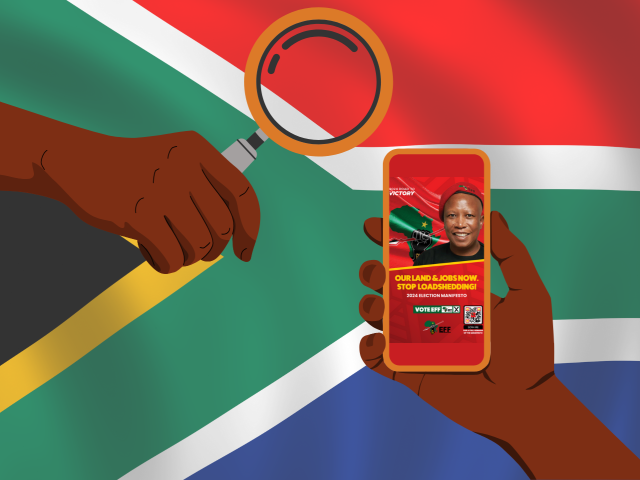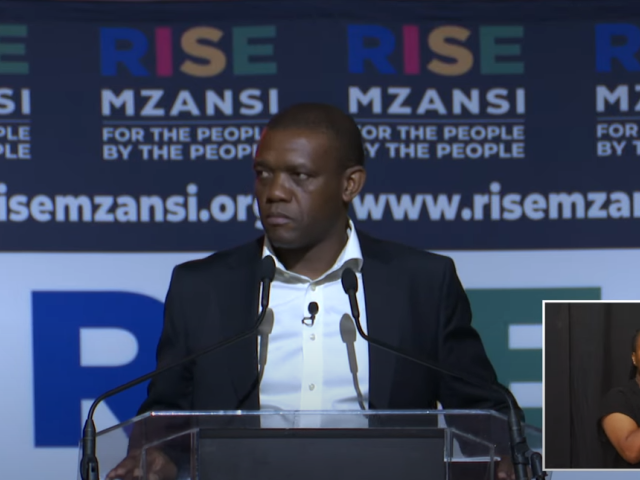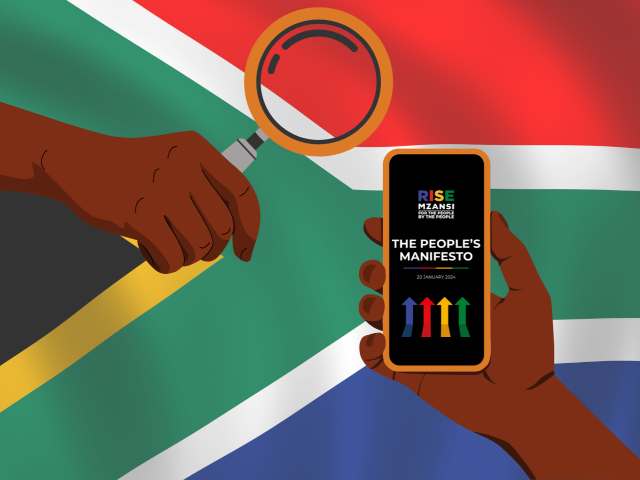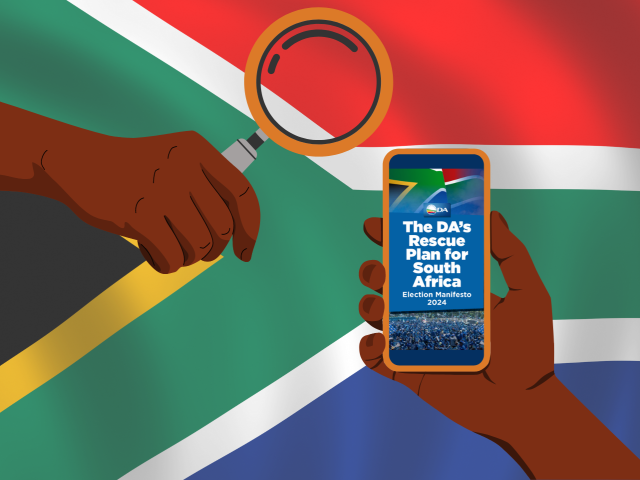-
The ruling party kept its earlier promise to implement the national minimum wage, though various factors still prevent all workers across South Africa from benefiting.
-
Five investment conferences have increased pledges to invest in the country, but how much money will flow into the economy as a result remains to be seen.
-
Many of the ANC’s earlier promises have been broken, including key social concerns such as reducing violent crimes against vulnerable groups and implementing a national health insurance.
South Africa’s ruling party, the African National Congress (ANC), launched its 2024 election manifesto on 24 February.
Under the slogan “Let’s do more together”, the party outlined six key (and broad) priorities:
- Put South Africa to work
- Build industries for an inclusive economy
- Tackle the high cost of living
- Invest in people
- Defend democracy
- Build a better Africa
If some of these sound familiar, that’s because the ANC campaigned on similar priorities in 2019, promising to create employment, increase levels of investment and deliver key social services.
In this report, we follow up on some of the commitments made in the ANC’s 2019 manifesto. After another five years in government, which promises have been met and which have been repeated in the 2024 manifesto?
Promise: “Increase police visibility in our communities by increasing the number of men and women in uniform.”
Verdict: Broken
Annual reports published by the South African Police Service, or SAPS, include the number of employees in the police force. According to the 2019/20 annual report, which covered April 2019 to March 2020, the SAPS had a total of 187,358 employees.
But this figure included all employees in the SAPS, not just police officers. If administrative staff are removed, the total is 151,577. Out of these, 97,598 people were employed under “Visible Policing”, a programme tasked with basic crime prevention at police stations and in communities, and policing country borders.
The most recent annual report, which covers April 2022 to March 2023, shows these figures have decreased. The SAPS recorded 179,502 total employees, or 147,622 without administrative staff, and 97,136 visible policing employees.
When asked about the claim, the ANC’s head of policy, Fébé Potgieter, told Africa Check that “an additional 20,000 police officers were recruited and trained in 2022 and 2023”.
SAPS reporting does mention efforts to recruit more officers in 2022 and 2023, though allegations of corruption have surrounded the drive. Police numbers in 2024 remain lower than in 2019.
Gareth Newham, head of justice and violence prevention at the Institute for Security Studies, previously told Africa Check that several factors had led to declining numbers, including SAPS promotion policies and worker dissatisfaction.
Increasing number of frontline police officers unlikely to have positive results
In the 2024 version of their manifesto, the ANC again pledged to “modernise policing with more frontline police officers”. However, according to Newham, without defining “modernising” it is unclear what the term means.
Ideally, Newham said, modernising could mean the SAPS developing a “clear vision and supporting doctrine” for dealing with South Africa’s crime epidemic and building public trust. But this would require completely overhauling its management system and strategic approaches, improving accountability and performance management, using technology and the digitisation of information.
Only increasing the number of frontline or visible police officers was unlikely to have positive results if done within the current “dysfunctional and outdated SAPS organisational system”, Newham said.
Promise: “Ensure the reduction of crime, especially violence against vulnerable groups.”
Verdict: Broken
Following the outbreak of Covid-19 in March 2020, president Cyril Ramaphosa described gender-based violence as South Africa’s “second pandemic”. High rates of violence against women have been met with public protest and media attention, while the government has been criticised for being complacent.
While the definition of vulnerable groups could also include other groups, Newham said that the term is generally interpreted to mean women and children.
So what do the statistics show?
More murders of women and children reported since 2019
In South Africa, violence is recorded under the category of “contact crimes” and includes assault, murder and sexual offences. The SAPS includes statistics for these crimes against women and children in their annual reporting.
But as we’ve previously written, the number of crimes reported is usually very different to the actual number committed. Police statistics cannot estimate the true scale of crime.
If there is any exception to this, it is murder. Statistics about this are considered to be relatively accurate, as they can be independently verified, and bodies are “hard to hide, dispute or ignore”, as Anine Kriegler and Mark Shaw of the University of Cape Town put it.
In its 2019/20 annual report (which covers April 2019 to March 2020), the SAPS recorded 2,695 murders of women and 943 murders of children.
Except for a small dip during the Covid-19 lockdown of 2020, the number of women murdered has increased every year since, with the latest available data showing that 3,422 women were murdered in 2022/23. The number of children murdered has fluctuated, but was higher in 2022/23 than in 2019/20, at 1,056.
Calculating murder rates
Experts prefer to use murder rates rather than total numbers to assess trends over time, as these account for changes in the population. A murder rate estimates the number of murders per 100,000 people over a specific time period.
For the total population of women and children in South Africa between 2019 and 2023, we used mid-year population estimates and general household surveys from Statistics South Africa (Stats SA), the country’s data agency.
According to the data, the murder rate for women stood at 13.4 per 100,000 in 2019 and increased to 16.64 in 2022. For children, the rate increased from 4.7 per 100,000 in 2019 to 5.06 in 2022.
This means violence against women and children, using murder as a proxy, has not been reduced. Africa Check ran these numbers by Prof Rachel Jewkes, an executive scientist at the South African Medical Research Council who has researched gender and violence for decades. She said this conclusion matched what was expected, with a “huge post-Covid increase” in murders.
Violence researcher Dr Nechama Brodie, head of the Wits Justice Project at the University of the Witwatersrand in Johannesburg, told Africa Check that viewing violent crimes against women and children together may be problematic for developing strategies to reduce them.
“We have several studies … which have closely examined the profiles of both female homicides and child murders,” said Brodie, which showed that murders of women and children often had different characteristics. Some examples of these can be found here, here and here. Looking at this as one issue “implies that both types of crimes have the same patterns and solutions, which is not true”, she said.
Newham added that tackling violence against vulnerable groups would require, among other strategies, a complete overhaul of visible policing systems, leading officers to “treat all people with respect and pay particular attention to people who appear vulnerable”.
In its 2024 manifesto, the ANC again pledged to address this problem, promising to “intensify the war on crime and make our communities safe … [including] action against gender-based violence and femicide”.
Promise: “Increase the levels of investment by R1.2 trillion over the next four years.”
Verdict: In progress
The South Africa Investment Conference was launched in 2018 and aims to promote the country as an investment and trade destination, locally and globally.
While the initial investment target was set at R1.2 trillion, in its 2024 election manifesto, the ANC claimed that the conferences had “raised R1.5 trillion in new investment commitments”.
Africa Check has been following this promise closely since 2019. In 2023, we fact-checked the claim that the fourth South Africa Investment Conference raised R367 billion in investment commitments. This was correct. At the time, this brought the total investment amount to R1.14 trillion.
The fifth South Africa Investment Conference was held in April 2023 and saw another R366 billion in pledges.
This brings the total amount pledged at all five investment conferences to R1.5 trillion.
Investment commitments are pledges
Jannie Rossouw, professor of economics at Wits Business School, previously told Africa Check that these investment commitments are simply pledges.
“It does not imply that investment will necessarily follow,” he said.
As online news publication Daily Maverick explained, “a final investment decision is generally taken after months or even years of number crunching, risk assessment, and massive legal and consulting bills”.
But according to the ANC’s 2024 election manifesto, of the R1.5 trillion in pledges, R500 billion “has already flowed into the economy”.
We asked South Africa’s Department of Trade, Industry and Competition (DTIC) about the claim. Annelize van der Merwe, director of Green Economy Industries, told Africa Check that the department tracked the implementation of more than 300 projects.
“Companies provide regular progress reports on how the investment is materialising in the economy.” This included reporting on investment flows, which was the actual investment spent in the country, Van der Merwe said. “It is correct that more than R500 billion of the R1,5 trillion has already been invested.
Van der Merwe said these figures were reported to parliament as part of the DTIC’s annual performance plan and sent Africa Check the most recent version.
The report showed that of the 317 investment pledges announced, 97 projects had been completed, 101 were under construction and 72 were in the early stages of implementation. The remaining 47 projects were delayed or in the funding stages.
As of 30 June 2023, R511.2 billion had flowed into the economy as a result of these projects.
We will keep track of this figure and in the interim rate this promise as “in progress”.
Promise: “Implement the national minimum wage.”
Verdict: Kept
According to the International Labour Organization (ILO), a minimum wage is the lowest amount a worker must be paid for their labour during a given period. This can include hourly, weekly, or monthly wages.
South Africa’s National Minimum Wage Act, signed into law in late 2018, set a minimum wage of R20 an hour for most of the country’s workers.
Initially, there were some exceptions, with the minimum wage for farm workers set at R18 and domestic workers at R15. However, farm workers began receiving the full national minimum wage (NMW) in 2021 and domestic workers in 2022.
The NMW has increased annually, from R20 an hour in 2019 to R27,58 an hour in 2024.
Workers employed by the Expanded Public Works Programme, which provides direct government contractual work, have their own minimum wage. This is currently set at R15,16 per hour.
Some of the considerations that go into calculating the new NMW each year include but are not limited to:
- Inflation and the cost of living
- Outcomes of collective bargaining
- The performance of the country’s economy
‘Limiting factors’ still preventing all workers from receiving minimum wage
The NMW is enforced by law and should an employer pay their worker less than the legal amount, the worker may approach the Commission for Conciliation, Mediation and Arbitration to file a complaint.
However, exemptions are allowed, as long as necessary conditions are met. The reason for the exemption must be stated – it is usually because the employer cannot afford the wage. The period for the exemption must also be specified and cannot exceed one calendar year. Lastly, the wage that the employer will pay must be stated.
In 2020, the Development Policy Research Unit (DPRU) at the University of Cape Town calculated that the number of workers earning below R20 an hour between October and December 2018 was 5,2 million. This made the NMW a “potentially hugely influential labour market intervention”, they said.
However, in a 2024 report, the research unit found that the NMW only affected 38% of employees who earned less than R20 in 2018. Benjamin Stanwix, a senior research officer at the DPRU, told Africa Check that although the NMW should, in theory, cover all workers across all sectors, there were limiting factors. These included the capacity for enforcement, exemptions, and the difficulty of overseeing the informal sector.
In its 2024 election manifesto, the ANC committed to ensuring the NMW increases in line with inflation and is fully complied with.
Promise: “Implement a national health insurance.”
Verdict: Broken
In its 2019 manifesto, the ANC said that it would “implement a national health insurance to provide quality health care free at the point of use”.
South Africa’s proposed national health insurance (NHI) is a tax-funded programme which would pay for healthcare services for all South Africans. There are examples of similar state-funded health services in other countries, including the UK’s National Health Service.
The proposed NHI has faced political pushback in the country, especially from the official opposition party, the Democratic Alliance, which has said that the NHI would “destroy” the South African healthcare system. Despite this, in June 2023, with 205 votes in favour and 125 against, South Africa’s parliament passed a bill which would implement an NHI.
The NHI Bill sets out the framework for an NHI fund and determines, among other things, how it should be run, who may benefit from the fund, and how mismanagement would be prevented.
For a bill to become law, it must go through a lengthy legal process. On 6 December 2023, the bill was sent to president Cyril Ramaphosa to be signed into law – the final step in the process.
In his state of the nation address on 8 February 2024, Ramaphosa quipped that the NHI Bill was on his desk and that he was “looking for a pen”.
Once the bill is signed into law, the NHI will not immediately come into effect. Foster Mohale, spokesperson for the health department, said he was unable to give a timeframe for full implementation until the president had signed the bill. That information would be announced once Ramaphosa had given the green light, he told Africa Check.
The ANC’s Fébé Potgieter told Africa Check that the Department of Health “has in the meantime been setting up structures and processes to ensure the effective implementation of the NHI”.
In its 2024 manifesto, a promise to implement the NHI “to make quality health care affordable and available to all” is again made.
Promise: “Establish a sovereign wealth fund.”
Verdict: Broken
According to the International Monetary Fund, a sovereign wealth fund (SWF) is “an entity that manages state-owned financial assets, and is legally structured as a separate fund or fund manager owned by the state”.
SWFs are created to stabilise an economy, increase savings across generations, fund a country’s development and for various other reasons, as outlined by the Sovereign Wealth Institute. And these funds are becoming increasingly popular among governments in Africa – there are around 25 of them across the continent.
The idea was previously proposed by South Africa’s second-largest opposition party, the Economic Freedom Fighters, in its founding manifesto, to “assist in the insulation of the South African economy”.
In his 2020 budget speech, then finance minister Tito Mboweni announced that R30 billion had been earmarked to create a Sovereign Wealth Fund for the country, as a “long-term tool for saving and investment for future generations”.
“We must learn to save during the good times,” the minister said.
According to Mboweni, numerous funding sources for the SWF existed, including from the extraction of natural resources, the sale of non-core state assets, and future fiscal surpluses. But, as the South African Institute for International Affairs (SAIIA) has noted, the specifics, such as how the fund would be structured and what its strategic objectives would be, have not been elaborated on.
And since Mboweni’s announcement, the government has been largely quiet on the topic, aside from repeating the promise of “finalising” the establishment of the fund in the 2024 ANC manifesto.
Feasibility of a sovereign wealth fund
Potgieter told Africa Check that the SWF had not been established because of “the severely constrained economic and fiscal environment” in the country. This environment, she said, was a result of several “shocks” to the economy, including the Covid-19 pandemic, the July 2021 civil unrest, the war in Ukraine, and April 2022 flooding in Durban in the KwaZulu-Natal province.
Dr Joseph Upile Matola, an economist at SAIIA, told Africa Check that a SWF remains a distant prospect for South Africa. “The country is simply not ready” due to “serious economic stagnation”, and high levels of debt.
Economic governance was another challenge, Matola said. “Most state-owned companies remain in distress and rely on government bailouts to continue operations.”
Apart from these enterprises needing the savings going to the fund, he said, poor management of state-owned enterprises also raised concerns about the “potential governance failure” of the fund.
Promise: “Create an extra 275,000 jobs each year.”
Verdict: Broken
Under its campaign for “more jobs, more decent jobs”, the ANC promised to “create an extra 275,000 jobs each year by boosting local demand for goods, investing more in mining, manufacturing and agriculture and expanding export markets”.
This would have seen nearly 1.4 million jobs created over five years.
In the last quarter of 2019, 16.4 million people were employed in South Africa. By the last quarter of 2023, this figure had risen to just over 16.7 million.
This is a far cry from what the ANC promised, but there is important context to consider.
Potgieter told Africa Check that “employment creation was severely disrupted by the Covid-19 pandemic”. She said employment plummeted in 2020 during the national lockdown put in place to prevent the spread of the virus.
South Africa was not the only country to see a decrease in employment during this period. Stats SA said that “most countries across the world” saw a decline and that “the picture observed in South Africa is in line with the rest of the world”.
Dr Neva Makgetla is a senior economist at the research institute Trade and Industrial Policy Strategies. She told Africa Check that the Covid-19 pandemic meant that the ANC’s 2019 manifesto promise became entirely unachievable. “South Africa lost 2.2 million jobs, or 14% of the total, in the lockdown – that is, in the second quarter of 2020.”
While the country did return to pre-pandemic levels of employment in early 2023, and eventually saw a slight increase in employment compared to pre-pandemic levels, Makgetla said it was “hard to link those trends to government economic policies”.
The ANC’s 2024 approach to creating employment
The party’s 2024 manifesto promises to “expand public employment to sustain 2.5 million work opportunities”. So what’s the difference between a work opportunity and a job?
Dr Kate Philip is the programme lead for the Presidential Employment Stimulus (PES), a programme that creates jobs through public employment. She told Africa Check that the term “work opportunity” is used to differentiate between opportunities provided by certain public employment programmes and “‘jobs’ in the wider labour market”.
Makgetla said that many public work opportunities only last a few months, and do not come with public service pay and benefits. The number of work opportunities created “ is effectively the number of people who for some period of time have been employed in a public employment scheme”, she said.
While not everyone would call it a “job”, these work opportunities often count as employment. Stats SA, in its quarterly labour force survey (QLFS), defines someone as employed, if during a specific week they “did any work for at least one hour, or had a job or business but were not at work (i.e. were temporarily absent)”. This is similar to the definition used by the International Labour Organization.
Funding will be the challenge
Public employment programmes are easier to connect to government policy, as they involve work opportunities provided directly by the state.
South Africa’s Expanded Public Works Programme currently provides most of the country’s public employment opportunities. As we’ve noted, these aren’t necessarily permanent jobs, but they do count as “employment” as measured by the QLFS.
In the 2022/23 financial year (1 April 2022 to 31 March 2023), the programme provided a total of 990,686 work opportunities. Data for the most recent financial year (2023/24) has not been released, but in its first three quarters (1 April 2023 to 31 December 2023) the programme provided 773,192 work opportunities. Previous years have also seen the programme providing slightly more or less than a million opportunities per year.
During the Covid-19 pandemic, South Africa introduced another public employment program, the PES. The PES creates new work opportunities and supports some existing jobs. As of December 2023, it had supported around 1.9 million work opportunities, 1.6 million of which were newly created work opportunities.
So public employment in South Africa already provides a significant number of work opportunities per year. Expanding these figures to 2.5 million doesn’t appear to be an impossible task, but “the challenge will be to get funding for it, given the constraints on the budget,” Makgetla said.






Add new comment